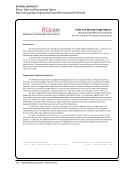SPEC Kit 329: Managing Born-Digital Special Collections and Archival Materials · 191
Yale University
Beinecke Rare Book &Manuscript Unit, Processing Manual. Electronic Files
seems to allow for it. See also RAD 9.5B2, ISAD(G) 3.1.5 and the Paradigm fonds-level
description recommendations, available at
http://www.paradigm.ac.uk./workbook/cataloguing/ead-fonds.html. As of April 2010,
recent professional practice and recommendations indicate use of gigabytes and
megabytes. That said, use the most appropriate file storage size per RAD 9.5B2. For
example:
Physical Description: 3.71 megabytes
In accordance with DACS 2.5.7, extent may be further defined through a parallel
statement. This could be used to record a large number of files. For example:
Physical Description: 227 megabytes (2,215 files)
Alternately, when the file storage size is not available, describe the quantity in terms of
material type(s) in accordance with DACS 2.5.5. See also RAD 9.5B3. This will be the
case when some or all formats are unreadable or, in baseline processing, if media has
not yet been fully accessioned. For example:
Physical Description: 57 computer disks
Similarly, in baseline processing, when the file storage size is not yet available, qualify
the statement to highlight the existence of the material type in accordance with DACS
2.5.6. For example:
Physical Description: 7 folders, including 3 computer disks
EAD allows for multiples statements of extent. When the digital records make up a
significant part of a hybrid collection or series/accession, provide two parallel
expressions of extent, one for the physical content and one for the digital content. For
example:
Physical Description: 4.17' (10 boxes)
Yale University
Beinecke Rare Book &Manuscript Unit, Processing Manual. Electronic Files
seems to allow for it. See also RAD 9.5B2, ISAD(G) 3.1.5 and the Paradigm fonds-level
description recommendations, available at
http://www.paradigm.ac.uk./workbook/cataloguing/ead-fonds.html. As of April 2010,
recent professional practice and recommendations indicate use of gigabytes and
megabytes. That said, use the most appropriate file storage size per RAD 9.5B2. For
example:
Physical Description: 3.71 megabytes
In accordance with DACS 2.5.7, extent may be further defined through a parallel
statement. This could be used to record a large number of files. For example:
Physical Description: 227 megabytes (2,215 files)
Alternately, when the file storage size is not available, describe the quantity in terms of
material type(s) in accordance with DACS 2.5.5. See also RAD 9.5B3. This will be the
case when some or all formats are unreadable or, in baseline processing, if media has
not yet been fully accessioned. For example:
Physical Description: 57 computer disks
Similarly, in baseline processing, when the file storage size is not yet available, qualify
the statement to highlight the existence of the material type in accordance with DACS
2.5.6. For example:
Physical Description: 7 folders, including 3 computer disks
EAD allows for multiples statements of extent. When the digital records make up a
significant part of a hybrid collection or series/accession, provide two parallel
expressions of extent, one for the physical content and one for the digital content. For
example:
Physical Description: 4.17' (10 boxes)










































































































































































































